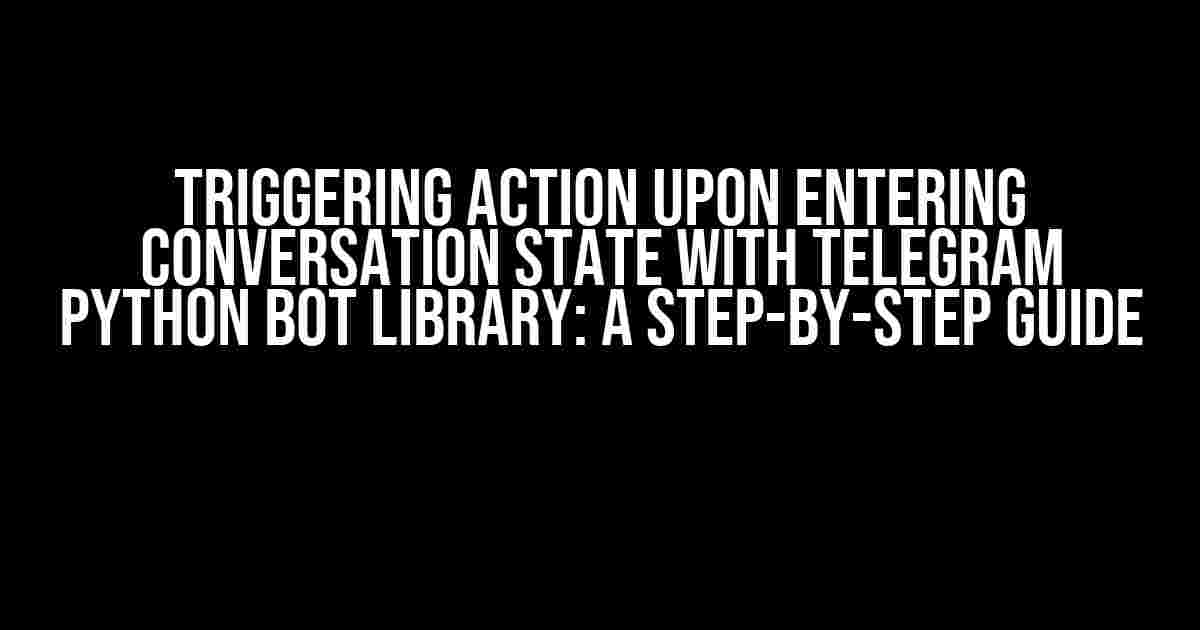Are you tired of manually checking for updates in your Telegram chatbot? Do you want to automate tasks upon entering a conversation state with your bot? Look no further! In this article, we’ll explore how to trigger actions upon entering a conversation state using the Telegram Python Bot Library.
What is the Telegram Python Bot Library?
The Telegram Python Bot Library, also known as python-telegram-bot, is a Python library that allows you to create Telegram bots easily. It provides a simple and intuitive API to interact with the Telegram Bot API, making it easy to build complex bots with minimal code.
What is a Conversation State?
A conversation state refers to the current state of a conversation between a user and a bot. In Telegram, a conversation state can be one of several types, including:
- START: The initial state of a conversation.
- CHOOSING: The user is choosing an option from a list of options.
- WAITING: The bot is waiting for the user to provide additional information.
- DONE: The conversation has been completed.
Triggering Action Upon Entering Conversation State
To trigger an action upon entering a conversation state, you’ll need to use the ConversationHandler class provided by the python-telegram-bot library. This class allows you to define a series of states and actions to be taken when entering each state.
Step 1: Create a Conversation Handler
Create a new instance of the ConversationHandler class, passing in the required arguments:
from telegram.ext import ConversationHandler, CommandHandler, MessageHandler
conversation_handler = ConversationHandler(
entry_points=[CommandHandler('start', start_conversation)],
states={
CHOOSING: [MessageHandler(Filters.text, choose_option)],
WAITING: [MessageHandler(Filters.text, wait_for_input)],
DONE: [MessageHandler(Filters.text, done_conversation)]
},
fallbacks=[CommandHandler('cancel', cancel_conversation)]
)
Step 2: Define the Conversation States
Define the conversation states and the actions to be taken when entering each state:
CHOOSING, WAITING, DONE = range(3)
def start_conversation(update, context):
update.message.reply_text('Choose an option:')
return CHOOSING
def choose_option(update, context):
update.message.reply_text('You chose option X')
return WAITING
def wait_for_input(update, context):
update.message.reply_text('Please provide additional information:')
return WAITING
def done_conversation(update, context):
update.message.reply_text('Conversation completed!')
return ConversationHandler.END
Step 3: Add the Conversation Handler to the Dispatcher
Add the conversation handler to the dispatcher using the add_handler method:
from telegram.ext import Updater
updater = Updater('YOUR_BOT_TOKEN', use_context=True)
dp = updater.dispatcher
dp.add_handler(conversation_handler)
updater.start_polling()
updater.idle()
Example Usage
Here’s an example of how you can use the conversation handler to trigger actions upon entering a conversation state:
| User Input | Bot Response | Conversation State |
|---|---|---|
| /start | Choose an option: | CHOOSING |
| Option X | You chose option X | WAITING |
| Additional information | Conversation completed! | DONE |
Conclusion
In this article, we’ve explored how to trigger actions upon entering a conversation state using the Telegram Python Bot Library. By using the ConversationHandler class and defining conversation states, you can create complex bots that automate tasks and provide a better user experience.
Remember to replace YOUR_BOT_TOKEN with your actual bot token and modify the conversation states and actions to fit your specific use case.
Best Practices
When building a Telegram bot, it’s essential to follow best practices to ensure a seamless user experience:
- Use clear and concise language in your bot responses.
- Keep your conversation states organized and easy to understand.
- Use meaningful variable names and comments to make your code readable.
- Test your bot thoroughly to ensure it works as expected.
Frequently Asked Questions
Here are some frequently asked questions about triggering actions upon entering a conversation state:
- Q: How do I handle multiple conversation states?
A: You can use the
statesdictionary to define multiple conversation states and actions to be taken when entering each state. - Q: Can I use the ConversationHandler with other Telegram Python Bot Library features?
A: Yes, the ConversationHandler can be used with other features, such asCallbacks and InlineQueryHandlers, to create complex and interactive bots.
- Q: How do I handle errors and exceptions in my conversation handler?
A: You can use try-except blocks to catch and handle errors and exceptions in your conversation handler.
By following this guide, you’ll be able to trigger actions upon entering a conversation state with your Telegram Python Bot Library bot. Happy coding!
Frequently Asked Question
Get ready to automate your conversations with Telegram Python Bot Library! Here are the answers to your most pressing questions about triggering actions upon entering a conversation state.
What is a conversation state in Telegram Python Bot Library?
A conversation state is a way to define a specific context or scenario in which your bot interacts with a user. It allows you to store and retrieve data specific to that conversation, enabling your bot to respond accordingly.
How do I trigger an action when a user enters a conversation state with my Telegram bot?
You can use the `ConversationHandler` class from the Telegram Python Bot Library to trigger an action when a user enters a conversation state. Simply define a handler function that will be called when the user enters the desired state, and pass it to the `ConversationHandler` constructor.
Can I trigger multiple actions upon entering a conversation state?
Yes, you can! The `ConversationHandler` class allows you to define multiple handler functions for a single conversation state. These functions will be called in the order they are defined, enabling you to perform multiple actions when a user enters the conversation state.
How do I store data specific to a conversation state?
You can use the `conversation` object provided by the `ConversationHandler` class to store and retrieve data specific to a conversation state. This object allows you to store arbitrary data, such as user inputs, conversation history, or any other relevant information.
Can I use conversation states to implement a finite state machine in my Telegram bot?
Absolutely! Conversation states are a perfect fit for implementing a finite state machine in your Telegram bot. By defining multiple conversation states and the transitions between them, you can create a robust and scalable conversation flow that responds to user inputs in a logical and consistent manner.
